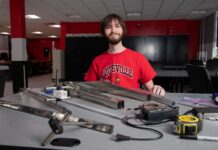LOUISVILLE, Ky. – The University of Louisville Conn Center for Renewable Energy Research has shown that solar energy can create clean hydrogen fuel by converting water vapor from the air.
The journal Energy and Environmental Science recently published “Solar hydrogen production from seawater vapor electrolysis” by Conn Center researchers Sudesh Kumari, R. Turner White, Bijandra Kumar, and Joshua Spurgeon. The article details a proof-of-concept system that could operate stably and efficiently at realistic conditions at the ocean’s surface.
Some of the major limitations of solar energy are that it is not available continuously and reliably and storing solar power can be challenging. The UofL team determined that using solar power to create clean fuels such as hydrogen provides an energy-dense storage solution that can readily be used in other applications such as transportation.
The Conn Center researchers demonstrated that solar energy could be used to create hydrogen from water vapor. Traditional electrolysis of water harnesses hydrogen by using pure deionized liquid water and runs at relatively high currents. Solar-driven electrolysis runs at a much lower current relative to the area it covers. Thus, solar hydrogen production can “breathe” water from the air without using fresh liquid water.
This breakthrough could lead to wider deployment of solar fuels technology, especially in coastal regions with high humidity but limited freshwater resources, such as California. In addition, the technology has the ability to be the first energy utility that produces, rather than consumes, fresh water.
Conn Center solar fuels research theme leader, Joshua Spurgeon, who leads the research, provided an important context for the work. “This is a direct demonstration of a viable solar fuels technology that could create a new market in offshore solar utilities with built-in energy storage to solve the intermittency issue, minimize land usage and environmental impacts of solar arrays and are the first energy facilities to be net freshwater producers,” he said.
Not only does the paper demonstrate the feasibility of stable solar hydrogen generation from ambient humidity, the findings also show that this is an indirect route to utilize vast reserves of ocean water. Direct electrolysis of liquid seawater is problematic because the salts and impurities can foul catalysts and contribute to corrosion. However, the ocean surface conditions are humid year-round. The UofL researchers demonstrated that seawater humidity can be converted to hydrogen via sunlight stably at the same efficiency achievable with liquid fresh water.
“This technology is also an important step toward providing personalized energy,” said Mahendra Sunkara, Conn Center Director. He further added “our solar fuels research team is making great progress towards durable technologies necessary for worldwide implementation”.
###
























